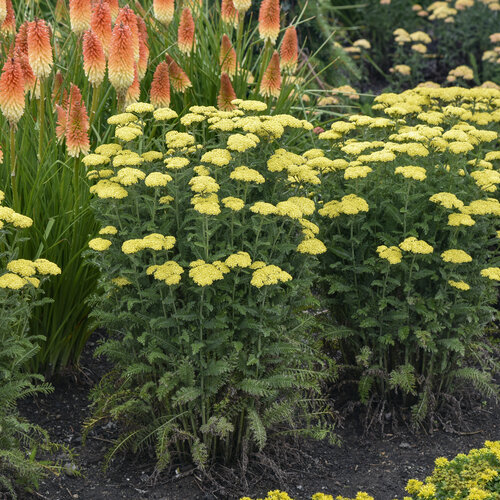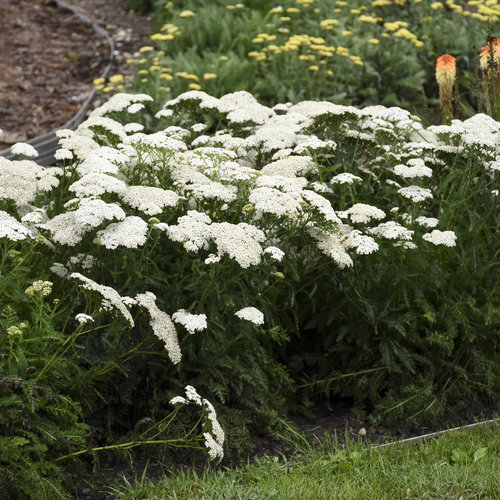Yarrow - The Ultimate Growing Guide from Proven Winners®
Grow this easy-care cottage garden favorite for long-lasting summer color

See all Proven Winners® yarrow varieties
A favorite for cottage-style borders and native gardens, yarrow (Achillea millefolium) provides summer-long color, even in the most challenging growing conditions. This hardy perennial produces flat-topped clusters of tiny flowers against a backdrop of ferny-green foliage. Yarrow flowers, which occur in range of different colors, are especially attractive to butterflies and other insect pollinators.
Native to North America, yarrow is an herb with different therapeutic uses. Plants are easy to grow, even for beginner gardeners. Hardy in most USDA zones, yarrow is versatile in cottage-style borders, waterwise strips, containers, and native landscapes. Here’s how to grow yarrow and use it in your yard.
YARROW CARE & PLANTING
How to plant: When planting yarrow, choose a site that receives at least 6–8 hours of full sun. The best time to plant is when all danger of frost is past in spring. Yarrow can also be planted in fall, at least 6 weeks before the average first frost dates in respective regions. Follow these steps, spacing yarrow plants 1–2 feet apart, depending on the variety.
- Loosen soil in the planting area and lightly amend with organic matter to improve drainage as needed.
- Remove the plant from its nursery container and gently tease out roots if potbound.
- Dig a hole slightly deeper and twice as wide as the root ball.
- Place yarrow plant in the hole so the crown of the plant is level with the surrounding soil.
- Fill in the hole with soil and tamp down lightly to remove air pockets.
- Water plants well. Provide regular water until roots are established.
Soil: Yarrow is tolerant of a range of soil types, performing best in lean, well-drained soil. If soil is too rich, it can cause plants to flop. Poorly draining soil may lead to root rot. For containers, use a high quality all-purpose potting mix.
Water requirements: Once established, yarrow is drought tolerant. Too much water can cause plants to flop, or result in root rot or other diseases. Wait until soil is dry before watering. Provide supplemental water during prolonged heat and dry spells.
Fertilizing: When growing yarrow, use little or no supplemental fertilizer. Overfertilizing may cause plants to flop, with excessive foliage growth at the expense of flowers. If desired, apply a thin layer of compost around the base of plants in spring.
Pruning: Pruning yarrow plants helps to maintain a more compact habit and encourage new blooms. In early spring, cut back dead stems before new growth emerges. Deadhead spent flowers to encourage new blooms. When cutting back yarrow after flowering, trim plants back by up to half their size for a possible rebloom in fall.
Find out more on planting and care from garden expert Stacy Ling of Bricks ’n Blooms: Read her yarrow tips.
TRY THESE PROVEN WINNERS® VARIETIES
The Proven Winners Firefly series of yarrows are bred for a more clumping rather than spreading habit, and stronger stems that are less prone to flopping. Try some of these charming varieties in your garden:
 | ‘Firefly Sunshine’
|
 | ‘Firefly Peach Sky’
|
 | ‘Firefly Diamond’
|
 | ‘Firefly Fuchsia’
|
 | ‘Firefly Red Pop’
|
YARROW FAQs
Is yarrow a perennial? Will yarrow come back every year?
Yarrow is an herbaceous perennial that comes back reliably from year to year and is hardy in most growing zones.
When should yarrow be cut back?
In early spring, cut back dead growth from the previous year. After plants are finished flowering in mid to late summer, plants can be cut back to encourage a second bloom.
Do yarrow plants spread?
Yarrow plants typically grow 2 to 3 feet tall, with an upright, clump-forming habit. These tough plants can fill in sunny, hard-to-plant spots and are useful in mass plantings where a tidy but textured look is desired.
What to do with yarrow after it blooms?
When yarrow plants are finished blooming, plants can be cut back by a third to a half of their size to encourage a late-season rebloom.
What not to plant with yarrow?
Yarrow prefers full sun, lean soil and little water. When planting yarrow in the garden, avoid placing alongside other plants with different growing needs such as astilbe, begonias, coral bells and hosta.
VIDEOS ON HOW TO GROW YARROW
Learn from trusted experts how to grow and use Proven Winners® yarrow:
YARROW LANDSCAPING IDEAS
- Attract pollinators by planting yarrow with aster, bee balm, butterfly bush, Joe Pye weed, and milkweed.
- For a charming cottage garden, combine with bee balm, dianthus, foxglove, hollyhock, lavender, phlox, roses and Shasta daisy. See more cottage garden plants.
- Pair with low-maintenance plants like black-eyed Susan, catmint, coneflower, daylily, ornamental grasses, Russian sage and salvia for carefree color all summer long.
- Grow yarrow in a container by itself or with other plants to add long-lasting color to a sunny deck, patio or apartment balcony.
- Design a waterwise parking strip with yarrow and drought-tolerant companions.
- Mass along slopes or hillsides to help prevent erosion.
- Include in fire-resistant landscapes. View firewise plants.
- Naturalize in a wildflower meadow with black-eyed Susan, blanket flower, columbine, cornflower, daisy, poppies and tickseed.
- Use in herb gardens alongside lavender, oregano, rosemary, sage and thyme.
- Include in a deer-resistant garden. See Sebastian Waite's picks for deer-resistant perennials.
COMPANION PLANTS
Plant yarrow alongside other plants with similar growing needs of full sun and lean, well-drained soil.
In borders or strips:
- ‘Cat’s Meow’ catmint
- Pyromania® ‘Orange Blaze’ red hot poker
- Denim ’n Lace’ Russian sage
- Rock 'N Round® 'Pure Joy' sedum
In summer borders:
- Color Coded® 'The Fuchsia is Bright' coneflower
- Rainbow Rhythm® ‘Ruby Spider’ daylily
- ‘Perfect Profusion’ perennial salvia
- Designer Threads™ ‘Heartstrings’ coreopsis
In herb gardens:
Buy Proven Winners plants:




